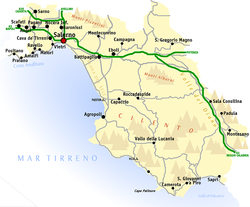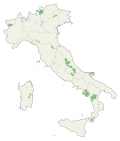| Cilento, Vallo di Diano and Alburni National Park | |
|---|---|
| Parco Nazionale del Cilento, Vallo di Diano e Alburni | |
 | |
 Salerno region | |
| Location | Campania |
| Nearest city | Salerno |
| Coordinates | 40°17′N15°28′E / 40.283°N 15.467°E |
| Area | 1,810.48 km2 (699.03 sq mi) |
| Established | 1991 |
| Governing body | Ministero dell'Ambiente |
| parks.it | |
| Official name | Cilento and Vallo di Diano National Park with the Archeological Sites of Paestum and Velia, and the Certosa di Padula |
| Type | Cultural |
| Criteria | iii, iv |
| Designated | 1998 (22nd session) |
| Reference no. | 842 |
| Region | Europe and North America |
Cilento, Vallo di Diano and Alburni National Park (Italian Parco Nazionale del Cilento, Vallo di Diano e Alburni) is an Italian national park in the Province of Salerno, in Campania in southern Italy. It includes much of the Cilento, the Vallo di Diano and the Monti Alburni. It was founded in 1991 and was formerly known as the Parco Nazionale del Cilento e Vallo di Diano.



